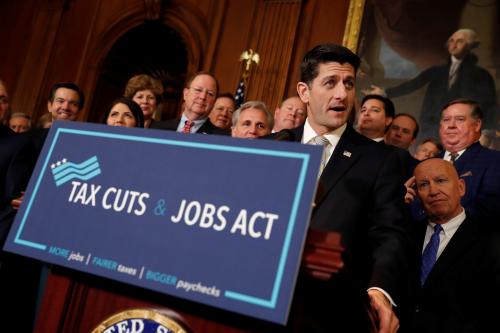This blog was originally published on the AEIdeas blog on September 23, 2019.
The Tax Cuts and Jobs Act of 2017 (TCJA, P.L. 115-97) was the largest tax overhaul since 1986. Rushed through Congress without adequate hearings and passed by a near-party-line vote, the law is a major legislative blunder badly in need of correction. The overall critique is simple: by providing large, regressive, deficit-financed tax cuts to an economy with low unemployment, rising long-term inequality, and high debt, the law was the wrong thing at the wrong time. It will take resources from future generations and from today’s lower- and middle-income households to enrich today’s well-to-do. It will take resources away from other badly needed social and economic priorities. The bill was so unpopular with the public that Republican members of Congress like Chris Collins and Lindsey Graham resorted to justifying their support by saying that their donors would cut off funding otherwise.
The law cut the corporate rate from 35% to 21%, repealed the corporate alternative minimum tax (AMT), transformed the taxation of foreign source income, introduced expensing of equipment investment, and provided a new deduction for qualified income earned in pass-through organizations. It also reduced personal income tax rates, eliminated the personal and dependent exemption, increased the standard deduction, expanded the child credit, adopted a less generous price index to annually adjust tax parameters, expanded exemption levels for the estate tax and the individual AMT, and eliminated the penalty on people who do not obtain adequate health insurance coverage. Almost all the individual income tax provisions – but not the price index change – expire after 2025, while most of the corporate income tax provisions – but not expensing – are permanent.
This blog, based on my own research and that of others, focuses on several key conclusions. Although it improved the tax code in some ways, TCJA will (a) have minimal impact on long-term growth; (b) increase disparities in after-tax income by giving the largest relative and absolute tax cuts to high-income households; (c) make most households worse off after taking into account plausible ways of financing the tax cut; (d) make the government’s troublesome long-term fiscal status even worse; (e) make the tax system more complex and more uncertain; (f) make it harder for policymakers to fight future recessions; (g) reduce health insurance coverage, raise health insurance prices, and (h) reduce charitable giving.
At the risk of stating the obvious, TCJA reduces federal revenues. Former Council of Economic Advisers Chair Kevin Hassett claimed that the corporate tax cut paid for itself, even though corporate tax revenues actually fell by 40 percent from 2017 to 2018 relative to pre-TCJA projected revenues. Despite assertions by Treasury Secretary Steven Mnuchin and numerous other Republican officials that the tax cut would not reduce revenues, estimates by the Congressional Budget Office and every other reputable estimating organization show that TCJA loses significant amounts of revenue. Even allowing for additional economic growth (discussed more below), the CBO places the increase in the primary deficit at $1.3 trillion over 10 years and the overall debt increase (counting interest payments) at $1.9 trillion. TCJA certainly reduced revenues in 2018. These reductions in revenues occur at a time when the government budget is deep in the red and heading deeper.
As a large, deficit-financed tax cut, TCJA stimulated the economy in the short-run via standard aggregate demand effects. But even those effects have been small. Despite the tax cut, a multi-hundred billion dollar budget deal in 2018, and favorable movements in oil prices and oil-related investments, GDP growth in 2018 was only 2.5 percent, below the Administration’s estimate of 3 percent. As Jason Furman points out in this series, economic growth in the six quarters following the passage of TCJA was slightly slower than in the six quarters preceding the law.
Most models indicate that the long-term effect on gross domestic product (GDP) will be small, even though corporate tax rates were cut permanently by 40 percent. Lower tax rates will create positive effects, but higher deficits will work in the opposite direction. The impact on gross national product (GNP), the income attained by Americans, will be even smaller because TCJA will lead to net capital inflows in the near term. Americans will have to be repay those inflows in future years, thus reducing their income (GNP) relative to Americans’ production (GDP). For example, CBO estimates that by 2028, TCJA will raise GDP by 0.5 percent but will raise national income—GNP—by only 0.1 percent. Allowing for the depreciation of capital, the effect on net national income is likely to be zero.
And TCJA could actually depress the economy once uncertainty is considered. Policy uncertainty tends to stifle economic activity. TCJA makes the future tax code less predictable, both because it expands deficits, thus raising the size of the eventual required policy adjustments to bring about fiscal stability, and because it sunsets many provisions that Congress may or may not extend.
Worse still, TCJA will make fighting recessions harder in the future. Tax burdens naturally rise and fall with income, serving as an automatic stabilizer. TCJA has reduced this stabilizing effect by lowering tax rates, limiting the deductibility of net operating losses, shifting to expensing from depreciation, and limiting deductible interest payments. In addition, by raising deficits, TCJA may make future policy makers more reluctant to engage in discretionary stimulus programs to boost an ailing economy.
TCJA is regressive and will make the distribution of after-tax income more unequal. Most of the tax cuts benefit high-income households. It provides significantly larger tax cuts to high-income households (in dollars and as a share of income) than to low-income households. When TCJA is eventually financed, the most plausible scenarios suggest that most households – and almost all low- and middle-income households – will end up being worse off than if TCJA had not been enacted.
In some ways, TCJA will simplify the tax system, namely by temporarily reducing the number of people who itemize their deductions. But in other ways, the law makes taxes much more complicated – particularly through its pass-through provisions and the international rules. TCJA also aimed to simplify the tax forms themselves, an effort that failed miserably.
The pass-through provisions reward past investment (which is pointless), they are extremely regressive (with 44 percent of the benefits going to households with income above $1 million), and they employ what appear to be arbitrary and capricious definitions and boundaries. They tax different forms of business income at different rates and they tax wages and business income at different rates; both features invite complicated avoidance and sheltering schemes.
By removing the penalty for not having adequate health insurance, the new law will reduce health insurance coverage by millions of households. By reducing marginal tax rates, TCJA will reduce charitable contributions.
Both the new provision for Opportunity Zones, which provides tax subsidies for investment in depressed areas, and the new provision for craft beverages, which reduces taxes on alcohol, are riddled with flaws and should be repealed.
One positive development is that TCJA will reduce the share of taxpayers who use the mortgage interest deduction by more than half, to only about 8 percent of tax filing units. This could well make it easier, politically, for policymakers to replace the deduction with a first-time homebuyers’ tax credit, which would be more effective in promoting homeownership, more progressive, and less expensive.
A second positive effect of TCJA is that the international rules have reduced incentives to keep profits overseas and reduced the value of tax avoidance via income shifting. Still, the international provisions have many shortcomings, described elsewhere.
What else should policy makers do? Repeal the individual rate cuts and the pass-through provisions (or let them expire as scheduled in 2025). Revisit the international rules. Raise the corporate rate to the 25-28 percent range, and institute full expensing. Enact a carbon tax. Close capital gains loopholes. And increase the budget for IRS enforcement to deal with a jaw-dropping tax gap that is now approaching $600 billion per year.
More generally, the nation faces a host of problems that will require added spending, addressing the debt, and new tax policies. TCJA takes away funds that could support those activities; thus, the problems it creates extend far beyond the narrow realm of tax policy.
The Brookings Institution is committed to quality, independence, and impact.
We are supported by a diverse array of funders. In line with our values and policies, each Brookings publication represents the sole views of its author(s).







Commentary
A fixable mistake: The Tax Cuts and Jobs Act
September 25, 2019